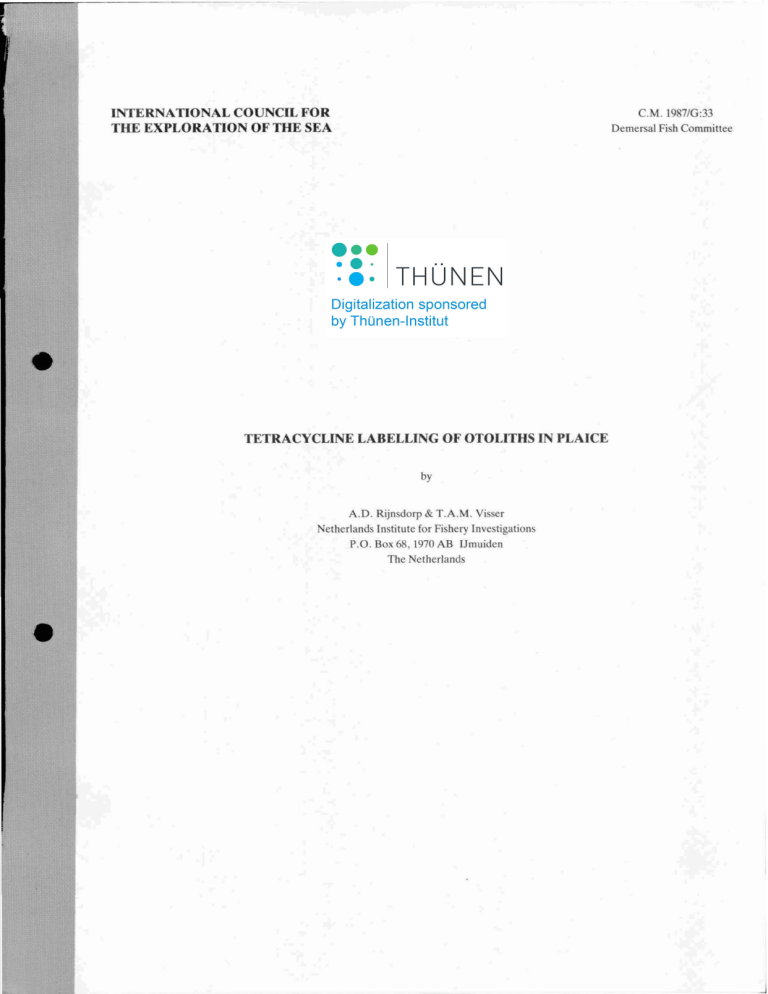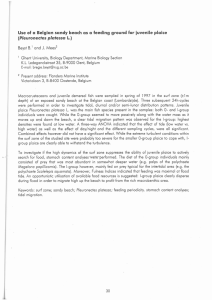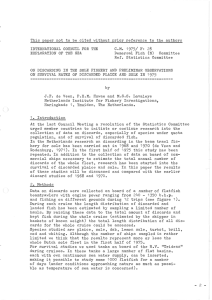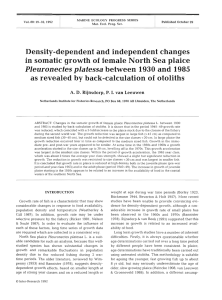I INTERNATIONAL COUNCIL FOR THE EXPLORATIO OFTHE SEA
advertisement

I
INTERNATIONAL COUNCIL FOR
THE EXPLORATIO OFTHE SEA
C.M. 1987/G:33
Demersal Fish Committee
TETRACYCLINE LABELLI G OF OTOLITHS I PLAICE
by
A.D. Rijnsdorp & T.A.M. Visser
etherlands Institute for Fishery Investigation
P.O. Box 68, 1970 AB IJmuiden
The Netherlands
J
INTERNATIONAL COUNCIL FOR
THE EXPLORATION OF THE SEA
C.M. 1987/G:33
Demersal Fish Comm
TETRACYCLINE LABELLING OF OTOLITHS IN PLAICE
A.D. RIJNSDORP and T.A.M. VISSER
Netherlands Institute of Fishery Investigations
RIVO
PO Box 68, 1970 AB IJmuiden
The Netherlands
•
Abstract
In this paper the results of a tagging experiment will be
presented in order to examine the validity of the back calculation
of previous lengths in the growth his tory of individual plaice.
To this end an experiment was conducted in the southern North Sea
in July 1985, in which 1039 plaice between 15 - 25 cm were tagged
with a Peterson tag and injected with oxytetracycline.
The
oxytetracycline gives a time-mark in the otoliths. From the
diameter of the tetracycline ring the length at tagging could be
back-ealeulated. 43 otoliths of plaiee recaptured within 2 and 19
months after tagging were available.
•
The observed and the baek-calculated growth showed a significant
eorrelation. The average observed growth was 5.29 em and eompared
to an average baek-ealculated
growth
of
5.90
em.
The
baek-ea1eulated length thus were on average 0.61 cm lower than the
observed length at tagging. This deviation between observed and
back-calculated length is close to the shrinkage of dead plaice
after capture (between 0.4 and 1.0 cm).
The deviation between
observed and baek-ealculated length at tagging was related to the
absolute growth increment:
highest deviations oecured at low
growth increments.
The plaiee that were recaptured in the month
of release showed a negative growth of 1.7 cm for which no
explaination could be given.
It was coneluded that the tetracycline experiment showed that -the
back calculation technique eould be applied in the study of
individual growth in plaice, provided that the growth increment
sufficiently exceeds the measurements error of fish-size and
otolith measurements.
In addition the variability in growth between seasons
and
individual plaice was studied. Growth in length occured between
April-May and October-November and showed a great variability
between individual plaice.
PAGE 2
1.
Introduction
Back-ca1cu1ation of the growth history of fish from annulus
can not only yield important information on the growth
of fish, but also opens the possibi1ity to study the al10cation of
energy over somatic growth and reproduction in individual fish
(Rijnsdorp 1986).
These app1ications of the back-ca1cu1ation
technique depend heavi1y on the accuracy of the back-calculations.
Till so far no test of the accuracy of the back-calculation
technique
in
analysing the growth of individual fish are
avai1ab1e.
diam~ters
Labe11ing oto1iths by chemica1 markers as tetracycline (Weber and
Ridgway
1962, 1967;
Jones and Bedford 1968) give us the
possibility to study this accuracy
direct1y.
Tetracycline
injected into the body cavity is assimilated and appears as a
fluorescent band in calciferous material as otoliths and bones.
In this paper the resu1ts of a tagging experiment are reported in
which plaice were tagged with the normal Peterson tag and injected
with
oxytetracycline.
A total of 43 otoliths taken from
recaptures between 2 and 19 months after tagging were analysed.
In addition the tagging experiment will be ana1ysed for the
individual variation in growth in length and the seasonal pattern
in growth.
2.
2.1.
•
Methods
Tagging.
Plaice with a length between 15 and 25 cm were tagged with a
Peterson tag between 9 and 11 July 1985 at position 5240 N, 420 E
(N=332) and position 5325 N, 515 E (N=707).
In· dddition each
plaice was injected with oxytetracycline in the body cavity at a
dose of 50 mg per kg fishweight. Tetracycline was dissolved in
Ringers solution in a concentration of 15 g/l. Length at tagging
was measured to the mm below.
2.2 Recaptures.
The recaptures were col1ected in severa1 fish auctions in the
Netherlands and collected by the RIVO afterwards.
Date and
position of recapture was recorded. Length (mm below) and weight
(nearest gram) were recorded at the RIVO and for part of the
recaptures at the fish auction directly after landing. Because of
the time interval between recapture date and landing, c.q.
measuring date the length at recapture is underestimated (c.f.
2.5.).
2.3 Otolith preparation.
The otoliths were viewed with a Zeiss microscope with UV light
(wave1ength 420 nm) using filters (G365,FT395,LP420) Otoliths were
first iospected for the presence of a tetracycline band.
PAGE 3
A total of 218 recaptures was available.
However in a great
number of these the growth was negligable or the otoliths were
broken. In 25% of the complete otoliths the tetracycline band was
invisible or very faint. Finally 52 complete otoliths showed a
clear fluorescent band of approximately 0.05 mm width.
These
otoliths were imbedded in resin, sectioned through the nucleus,
photographed and finally the diameter of the tetracycline band and
the total otolith were recorded.
43 were sectioned along the
longitudinal axis. Of 9 others a cross section was made.
2.4.
•
Back-calculation.
It was assumed that the growth of otolith-size and fish-size is
strictly proportional. This was checked by studying the relation
between otolith-size and fish-size in a sample of 118 otoliths
from plaice sampled in the southern North Sea in 1985 and 1987.
Only symmetrical otoliths were selected and the otolith-size was
determined along the logitudinal axis.
The results of the
regression analysis are shown in Table 1 and in Fig.l.
The
functional regression line does not pass through the origin but
gives an intercept with the Y-axis of 0.5 mm.
The length at tagging
following relation:
Lt =
where
•
Lr.
was
back-calculated
according
to
the
(Otc - 0.50) / (Otot - 0.50)
= Length at tagging in mm,
Lt
Lr
= Length at recapture in mm,
Otc = diameter of tetracycline ring in mm,
diameter of total otolith in mm.
Otot
In applying the correction
factor
of
0.50
mm
in
the
back-calculation the assumption is made that each individual
This
plaice of zero length has an otolithsize of 0~5 mm.
correction reduces the back-calculated length of recaptured fish
of 30 cm by about 0.5 cm.
2.4 Change in length of plaice after catching
In order to estimate the change in length of plaice after
catching, two groups of 25 plaice each were measured 1ndividually
to the mm below directly after catching. Group A plaice were put
in a plast1c bag and deepfrozen at -20 degrees C for 3 weeks.
After defrosting overnight length measurements were taken.
Group
B plaice were left on board for about 12 hours (T = +/- 14 oC) in
an open fish basket before measuring the length.
Finaly both
groups were put at 4 degrees in an open f1sh basket and remeasured
after 24 hours.
PAGE 4
. 3.
3.1.
Results
Comparison of back-ca1cu1ated and observed growth.
In Fig.2 the relation between the back-ca1cu1ated and observed
growth is shown.
The regression coefficients of the functional
regression (r=0.918, n=43) are: intercept u = 0.791 (95% c.l.
0.081
1.501) and slope v = 0.966 (95% c.1. 0.846 - 1.086).
Because the slope does not differ significantly from 1.0, the
functional regression line runs parallel to the line representing
strict equality between back-ca1culated and observed growth.
The
adjusted means however are significantly different by 0.6 em
(P(0.05).
•
Tbe frequency distribution of the deviations between the observed
and the back-calcu1ated growth also show that the baek-ealeulated
growth is on average slightly higher than the observed growth
(Fig.3).
In Fig.4. it is shown that these deviations especially
occur in fish with little growth. The individual variations in
the deviations are rather high but the mean deviation stabilize at
a difference of less than -0.5 cm at overall growth increments of
)= 4cm.
3.2.
Change in fishlength after capture
In Table 2 the results of the change in length at different
storing
regimes are given.
The mean length of 25 plaice
deepfrozen for 3 weeks at -20 oC (group A) decreased with 2.4%
from 23.73 cm to 23.15 cm. After pro1onged storing for 24 hours
in an open fish basket at 4 oC the average length decreased to
23.04 em.
•
Tbe mean length of Group B plaice stored for 12 hours in an open
fish basket at +- 14 oC deereased by 1.2% from 23.13 cm to 22.86
cm. prolonged storing for 24 hours in an open fish basket at 4 oC
reduced the mean length by 0.6% to 22.72 em.
The overall decrease in mean 1ength of group A and
0.41 and 0.69 cm and 1.8% and 2.9% respeetive1y.
3.3.
B plaice
was
Seasonal and individual variability in growth of tagged fish
In Fig.5. the observed growth of all 218 reeaptures have been
plotted 'against the number of months after tagging. Tbe period
over which growth in length oecur reaehes from April-May till
Oetober-November.
Between November and April growth in length
virtually stops. Tbe mean growth by month is given in Table 3.
The plaice recaptured within the same month after tagging (=
within three weeks) show a negative growth. Even of the plaiee
recaptured in August about 50% show a negative growth.
PAGE 5
The great individual variation in growth is striking throughout
the
observation
period.
Twelve months after tagging the
differenee in growth ranges from a minimum of 2.5 em to over 10
em •.
4.
•
Diseussion
The deviation of the baek-ealeulated length and the length at
tagging is influeneed by:
1) measurement errors in length determinations.
2) shrinking of fish after reeapture before length measurement.
3) variability in direet proportionality of otolith growth and
growth of fish size.
ad 1. No estimate of the error in the length determinations is
available.
A systematie bias in length determination seems
unlikely. This error term is assumed to be responsible for part
of the variation in individual growth. Length determinations of
live and moving fish will be less preeise and even may have a
systematie bias. This possibility should be eheeked in future.
ad 2. The order of magnitude of the shrinking of plaiee after
eapture is about 0.5 em or 2%. Johansen (cited in Hiekling 1937)
reported an average shrinkage in plaiee between 0.5 and 1.0
depending on the time.
Ouwehand (1973) reported an average
shrinkage of 0.54 em in soles.
t
Although in praetiee the treatment of reeaptured plaiee is
variable before length measurements are taken: storing on deck in
different seasons, storing on
iee,
deepfreezlng,
variable
time-periods ete, the figures above are in elose agreement and
will therefore give an aeeeptable estimate of the
average
shrinkage of reeaptured plaiee between 0.5 and 1.0 em.
The average differenee between the baek-ealeulated and observed
length (0.6em) are in elose agreement with the shrinking of plaiee
after eapture. The influenee of shrinking on the aeuraey of the
baek-ealeulated length will be smaller as growth is high. In a
tagged fish with zero growth shrinking of 1 em after eapture will
lead to a deviation of 1 em between the baek-ealeulated and
observed length at tagging. In a fish that grew from 20 em to 25
em the shrinking of 1 cm will lead to a deviation of 0.8 cm
(20-20/25*24). This explains apart of"the higher deviations at
low growth inerements in Fig.4.
The observed negative growth of plaiee reeaptured within the month
of release is mueh too large to explain by shrinking alone. If
the observed negative growth of -1.7 cm (Table 3) is related to
the bias in measuring the length of live plaice at tagging, this
bias will be about 0.7 - 1.2 em after correetion for shrinking.
Consequently the deviations of the baek-ealculated and observed
PAGE 6
length at tagging will change by 0.7 - 1.2 cm.
ad 3. The back-calculations are based on a direct proportionality
of otolith-size and fish-size as illustrated in Fig.1. Because
the relation does not go through the origin we have assumed that
for each individual a similar otolith-size at zero length applies
(0.5 mm). Variation in this otolith size will influence the
back-calculated length.
can
conclude
that
From
the
available
information
we
back-calculated length in plaice can be used to study the
individual growth giving an unbiased estimate of the growth
increment.
However in the case of small growth we should be
cautious because the measurement errors are likely to exceed the
realised growth •
•
5.
Literature
Hickling, C.F. 1937. The English plaice marking experiments.
Fish. lnvest. Ser 11, 16(1) (mimeo).
Jones, B.W. and B.C. Bedford 1968. Tetracycline labelling
as an aid to the interpretation of otolith structures in age determination - a progress report.
ICES CM 1968/Gen: 11 (mimeo).
Ouwehand, P. 1973. Krimpbepaling bij tong. IVP-TNO Report
nr 1-55 (mimeo).
Rijnsdorp, A.D. 1986. On the mechanism of energy allocation
over reproduction and somatic growth with particular
reference to female plaice. lCES CM 1986/L:9 (mimeo).
Weber, D.D. and G.J. Ridgway, 1962. The deposition 6f
tetracycline drugs in bones and scales of fish and
its possible use for marking. The Progressive
Fish Culturist 29(3):150-155.
Weber, D.D. and G.J. Ridgway, 1967. Marking Pacific salmon
with tetracycline antibiotics. J. Fish. Res. Bd.
Canada 24(4):849-865
PAGE 7
Table 1.
•
Regression coefficients of the functional
regression of otolith-size (Y) and length of
p1aice (X): Y = u + v X with 95% confidence
limits.
u
95% c.!.
v
0.50
0.24-0.76
0.195
Table 2.
95% c.!.
0.187-0.203
The change in length of plaice in
the method of storing.
r
n
0.977
118
relation to
A
Group
B
mean
sdev
mean
sdev
Length after capture
23.73
1.95
23.13
1.24
Length after treatment 1
23.15
2.01
22.86
1.19
Length after treatment 2
23.04
1.97
22.72
1.26
Overall shrinkage
0.69
0.41
PAGE 8
Table 3.
Growth increment by month after tagging plaice
between 9 and 11 July 1985.
1985
July
August
September
October
November
December
me an sdev
Female
Male
Total
n
mean sdev
n
0.95
2.14
2.27
1.92
2.30
1.83
8
12
-1.7
0.2
1.5
2.5
3.6
1.6
1.47
1.84
1.61
2.14
2.39
1.58
16
20
29
26
28
11
-1.3
0.3
1.7
3.5
3.4
3.6
2.5
3.8
3.7
4.5
5.7
4.7
5.5
7.2
7.6
8.2
9.3
1.82
0.54
0.67
1.61
1.69
2.85
3.02
1.92
2.08
2.13
4.53
1. 79
7
4
3
4
9
12
11
6
6
9
5
5
2.2
2.9
4.8
3.6
3.7
6.9
4.3
7.3
7.0
8.3
10.9
1.35
0.59
2.74
1.49
1.63
2.47
5.22
10.1
8.4
3.23
1.51
4
3
7.4
7.7
0.78
1.27
2.0
mean
sdev
n
-2.1
0.1
1.4
1.9
3.5
1.3
1.98
1.37
1.13
2.07
2.54
1.44
7
8
17
16
16
6
1
4
4
5
3
2
3
4
1
3.8
2.1
3.8
3.3
5.3
6.7
2.9
6.6
7.3
7.9
7.7
8.9
1.88
0.57
0.66
1. 76
1.70
3.02
1.86
1. 74
2.52
2.11
6
2
3
3
5
8
6
3
4
6
1
4
2
2
12.9
9.8
0.28
11
10
10
5
1986
January
February
March
April
May
June
July
August
September
October
November
December
0.07
1
2
1. 78
1987
January
February
•
2
1
PAGE 9
Otolith-slze (mm)
12.00
u.
10.00
9.00
..........
t ....
...... ;
8.00
.
.
'
7.00
6.00
...
.
.....'..
'
5.00
'
'~t: •
....
~.OO
3.00
2.00
1.00
Flsh-slze (ern)
Figure L
North Sea plaiee
Relation between otolith-size (mm) and fish-size (ern)
12
.~,
I[
.....u
10
.c
....
II
a
8
c..
Q'1
"'CI
6
::I
u
4
"
u
"""
2
....u
"
u
.:.:
0
0
Figure 2.
2
4
6
8
10
12
Observed growth (cn)
The relation between backcalculated and observed
growth.
PAGE 10
20
15
10
5
•
o.J.-U+lL--lLf.LJ.-.JLlrL.L---LJ+.A:-..LL.,JUL.-l.L.f.l.L.-----"r--2
{-2.S
-I
0
tl
Deviation in
Figure 3.
)2.5
t2
C~.
Frequency distribution of deviations between
backcalculated and observed length.
Deviation backcalculated
and observed growth
2
0
0
0
!€Jo
0
.
o0
-I
0
•
7.~cn·~-o'\.r
0
0
0
~c
-2
0
0
•
0
0
0
0
0
o
0
0
-3
0
-4
0
Figure 4.
2
4
8
6
Observed growth
10
12
(C~)
The relation between the deviation of the
backcalculated and observed growth and the
observed growth.
Growth (em)
19.00
17.00
.
15.00
I
13.00
11.00
I'
t',
(
~
1I
I;
i1
1
J
•
9.00
7.00
:t
l
"
"
'j
5.00
e
•
1
,
,
"
3.00
:1
Ji
"
1.00
I:
;1
!~
!:• 1
,"
•
i:
•
-1.00
"i,;,I
-3.00
I
-5.00,L--.:·:.-....-L_--1-_......l-_.L----1--.L..--L--...L-..-J:--.L----1.-----I
-1.00
3.00
7.00
11.00
15.00
19.00
23.00
,
.
Month after tagging
I
I,
,
~,
NORTH SEA PLAICE 1985, 1986
Observed growth increment after tetracycline tagging
,
,
,
,
,
'"
,
r
r
r
,
r
,
,
,


